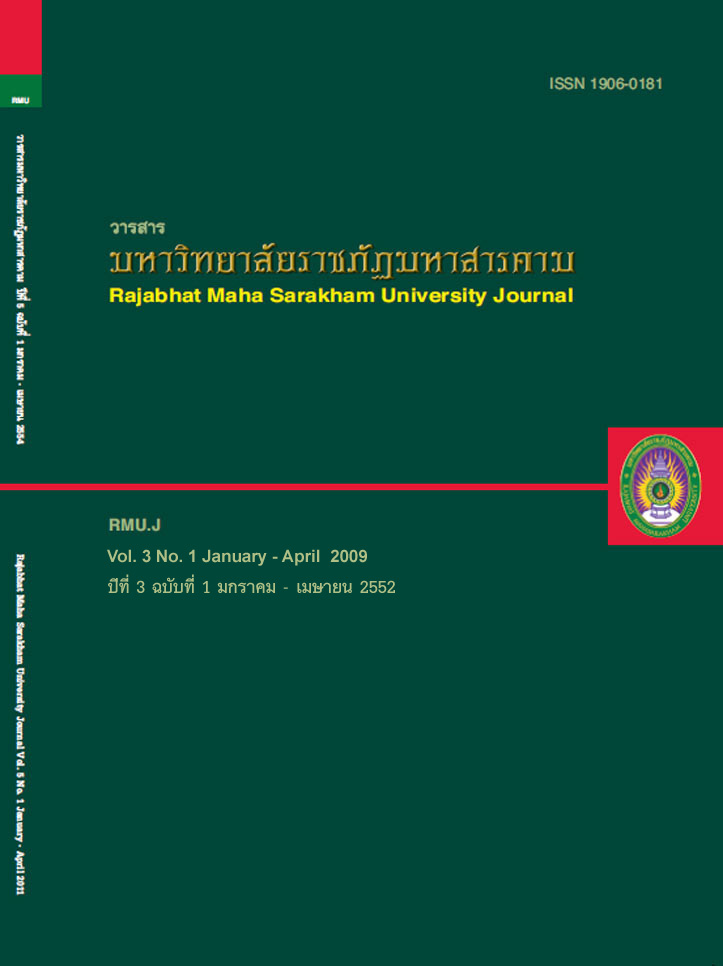การฝึกทักษะการสื่อสารในชีวิตประจำวันของเด็กออทิสติกโดยใช้ป้ายกระดานสื่อสาร Practices of Communication skills in Daily life for Autistic Children through Communicative Billboards
Main Article Content
บทคัดย่อ
การวิจัยครั้งนี้มีวัตถุประสงค์ ประการแรกเพื่อฝึกทักษะการสื่อสารในชีวิตประจำวันของเด็กออทิสติกโดยใช้ป้าย
กระดานสื่อสาร และประการที่สองเพื่อเปรียบเทียบความสามารถในการสื่อสารของเด็กออทิสติกก่อนและหลังการฝึก โดยใช้ป้าย
กระดานสื่อสาร กลุ่มเป้าหมายการศึกษาเป็นเด็กออทิสติกที่เข้ารับบริการฟื้นฟูสมรรถภาพที่ศูนย์การศึกษาพิเศษ มหาวิทยาลัย
ราชภัฏมหาสารคาม จำนวน 6 คน ที่มีอายุระหว่าง 3 ถึง 16 ปี เป็น ชาย 4 คน หญิง 2 คน เป็นผู้ที่ได้รับ การวินิจฉัยจากแพทย์
จัดเป็นเด็กออทิสติกที่มีปัญหาทางด้านภาษาและการสื่อสาร และกำลังศึกษาอยู่ในห้องเรียนออทิสติก ศูนย์การศึกษาพิเศษ
มหาวิทยาลัยราชภัฏมหาสารคาม เป็นการวิจัยเชิงการทดลอง ใช้แผนการทดลองแบบกลุ่มเดียว (Single subject design)
ตามรูปแบบ Basic A–B (Baseline and intervention design) เครื่องมือการวิจัย ประกอบด้วย แผนการสอน สื่อการสอน
โดยใช้ป้ายกระดานสื่อสาร แบบประเมินความสามารถในการสื่อสารของเด็กออทิสติกก่อนฝึกและหลังฝึกทักษะ ใช้เวลาดำเนิน
การทดลอง 10 สัปดาห์ วิเคราะห์ข้อมูลแสดงเป็นค่าเฉลี่ย และค่าส่วนเบี่ยงเบนมาตรฐาน ผลการวิจัยพบว่า
เด็กออทิสติกที่ผ่านการฝึกด้วยป้ายกระดานสื่อสารโดยเฉลี่ยมีความสามารถทางการสื่อสารที่ใช้ในชีวิตประจำวัน
ทางด้านการใช้ภาษาท่าทางและด้านการใช้ภาษาพูดอยู่ในระดับดีมาก โดยเด็กออทิสติก จำนวน 4 คน มีทักษะการสื่อสารอยู่ในระดับดีมาก อีก 2 คนอยู่ในระดับดี
The purposes of this research were to train communicative skills used in daily life for autistic
child through communicative billboards and to compare communication abilities of autistic child at
before–after practicing. Population were 6 autistic children (4 boys and 2 girls) attained rehabilitation
program at Special Education Center, Rajabhat Maha Sarakham University with aging ranged from 3 – 16
years old. The group of children were judged by clinical doctors as the autistic children on language and
communications skills. These children are studying at the autistic classroom, Special Education Center, Rajabhat Maha Sarakham University. The research were the Single Subjective Design of Basic A-B type
(Baseline and Intervention Design). Tools used in the research were course outline for communicative
billboards, instruction media with communicative billboards, assessment for communication skills of
autistic children at before-after usage of communicative billboards. Total time spent for this experimental
study was 10 weeks. Statistics used in this research were Means and Standard Deviation.
The results were found that ;
The overall communication skills in daily life on body language and speech aspects of autistic
children has been practiced with communicative billboards are at excellent level. When individual autistic
child was considered, it was found that communication skills of 4 children are at excellent level. The
communication skills of 2 remaining children are at good level.
The autistic children have higher level of communicative skills in their daily life after they havebeen trained for communicative skills with utilization ofcommunicative billboards.
กระดานสื่อสาร และประการที่สองเพื่อเปรียบเทียบความสามารถในการสื่อสารของเด็กออทิสติกก่อนและหลังการฝึก โดยใช้ป้าย
กระดานสื่อสาร กลุ่มเป้าหมายการศึกษาเป็นเด็กออทิสติกที่เข้ารับบริการฟื้นฟูสมรรถภาพที่ศูนย์การศึกษาพิเศษ มหาวิทยาลัย
ราชภัฏมหาสารคาม จำนวน 6 คน ที่มีอายุระหว่าง 3 ถึง 16 ปี เป็น ชาย 4 คน หญิง 2 คน เป็นผู้ที่ได้รับ การวินิจฉัยจากแพทย์
จัดเป็นเด็กออทิสติกที่มีปัญหาทางด้านภาษาและการสื่อสาร และกำลังศึกษาอยู่ในห้องเรียนออทิสติก ศูนย์การศึกษาพิเศษ
มหาวิทยาลัยราชภัฏมหาสารคาม เป็นการวิจัยเชิงการทดลอง ใช้แผนการทดลองแบบกลุ่มเดียว (Single subject design)
ตามรูปแบบ Basic A–B (Baseline and intervention design) เครื่องมือการวิจัย ประกอบด้วย แผนการสอน สื่อการสอน
โดยใช้ป้ายกระดานสื่อสาร แบบประเมินความสามารถในการสื่อสารของเด็กออทิสติกก่อนฝึกและหลังฝึกทักษะ ใช้เวลาดำเนิน
การทดลอง 10 สัปดาห์ วิเคราะห์ข้อมูลแสดงเป็นค่าเฉลี่ย และค่าส่วนเบี่ยงเบนมาตรฐาน ผลการวิจัยพบว่า
เด็กออทิสติกที่ผ่านการฝึกด้วยป้ายกระดานสื่อสารโดยเฉลี่ยมีความสามารถทางการสื่อสารที่ใช้ในชีวิตประจำวัน
ทางด้านการใช้ภาษาท่าทางและด้านการใช้ภาษาพูดอยู่ในระดับดีมาก โดยเด็กออทิสติก จำนวน 4 คน มีทักษะการสื่อสารอยู่ในระดับดีมาก อีก 2 คนอยู่ในระดับดี
The purposes of this research were to train communicative skills used in daily life for autistic
child through communicative billboards and to compare communication abilities of autistic child at
before–after practicing. Population were 6 autistic children (4 boys and 2 girls) attained rehabilitation
program at Special Education Center, Rajabhat Maha Sarakham University with aging ranged from 3 – 16
years old. The group of children were judged by clinical doctors as the autistic children on language and
communications skills. These children are studying at the autistic classroom, Special Education Center, Rajabhat Maha Sarakham University. The research were the Single Subjective Design of Basic A-B type
(Baseline and Intervention Design). Tools used in the research were course outline for communicative
billboards, instruction media with communicative billboards, assessment for communication skills of
autistic children at before-after usage of communicative billboards. Total time spent for this experimental
study was 10 weeks. Statistics used in this research were Means and Standard Deviation.
The results were found that ;
The overall communication skills in daily life on body language and speech aspects of autistic
children has been practiced with communicative billboards are at excellent level. When individual autistic
child was considered, it was found that communication skills of 4 children are at excellent level. The
communication skills of 2 remaining children are at good level.
The autistic children have higher level of communicative skills in their daily life after they havebeen trained for communicative skills with utilization ofcommunicative billboards.
Article Details
รูปแบบการอ้างอิง
Supattra Pasunkhato ส. ป. (2015). การฝึกทักษะการสื่อสารในชีวิตประจำวันของเด็กออทิสติกโดยใช้ป้ายกระดานสื่อสาร Practices of Communication skills in Daily life for Autistic Children through Communicative Billboards. วารสารมหาวิทยาลัยราชภัฏมหาสารคาม, 3(1), 51–58. สืบค้น จาก https://so05.tci-thaijo.org/index.php/rmuj/article/view/30309
ประเภทบทความ
บทความวิจัย
1. บทความที่ลงตีพิมพ์ทุกเรื่องได้รับการตรวจทางวิชาการโดยผู้ประเมินอิสระ ผู้ทรงคุณวุฒิ (Peer Review) สาขาที่เกี่ยวข้อง อย่างน้อย 3 ท่าน ในรูปแบบ Double blind review
2. ข้อคิดเห็นใด ๆ ของบทความที่ลงตีพิมพ์ในวารสารมหาวิทยาลัยราชภัฏมหาสารคาม นี้เป็นของผู้เขียน คณะผู้จัดทำวารสารไม่จำเป็นต้องเห็นด้วย
3. กองบรรณาธิการวารสารมหาวิทยาลัยราชภัฏมหาสารคาม ไม่สงวนสิทธิ์การคัดลอกแต่ให้อ้างอิงแสดงที่มา


